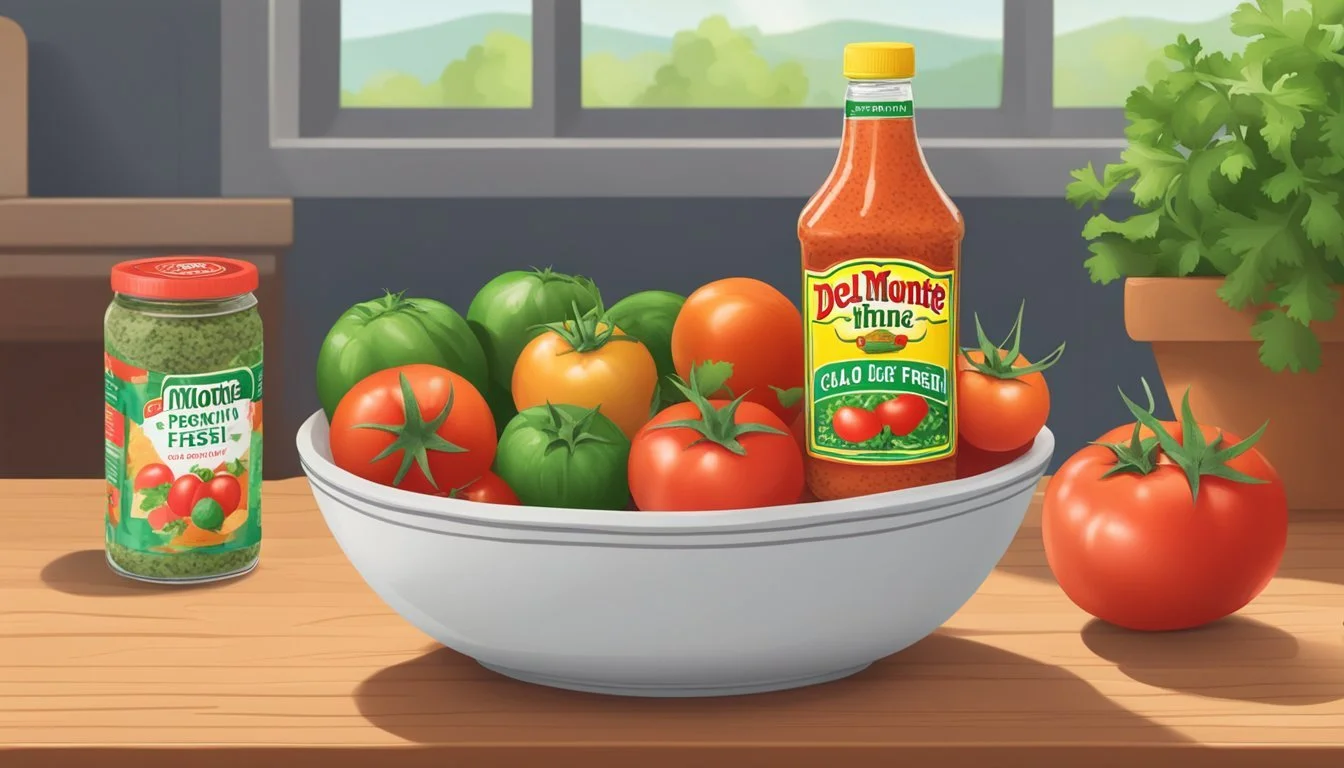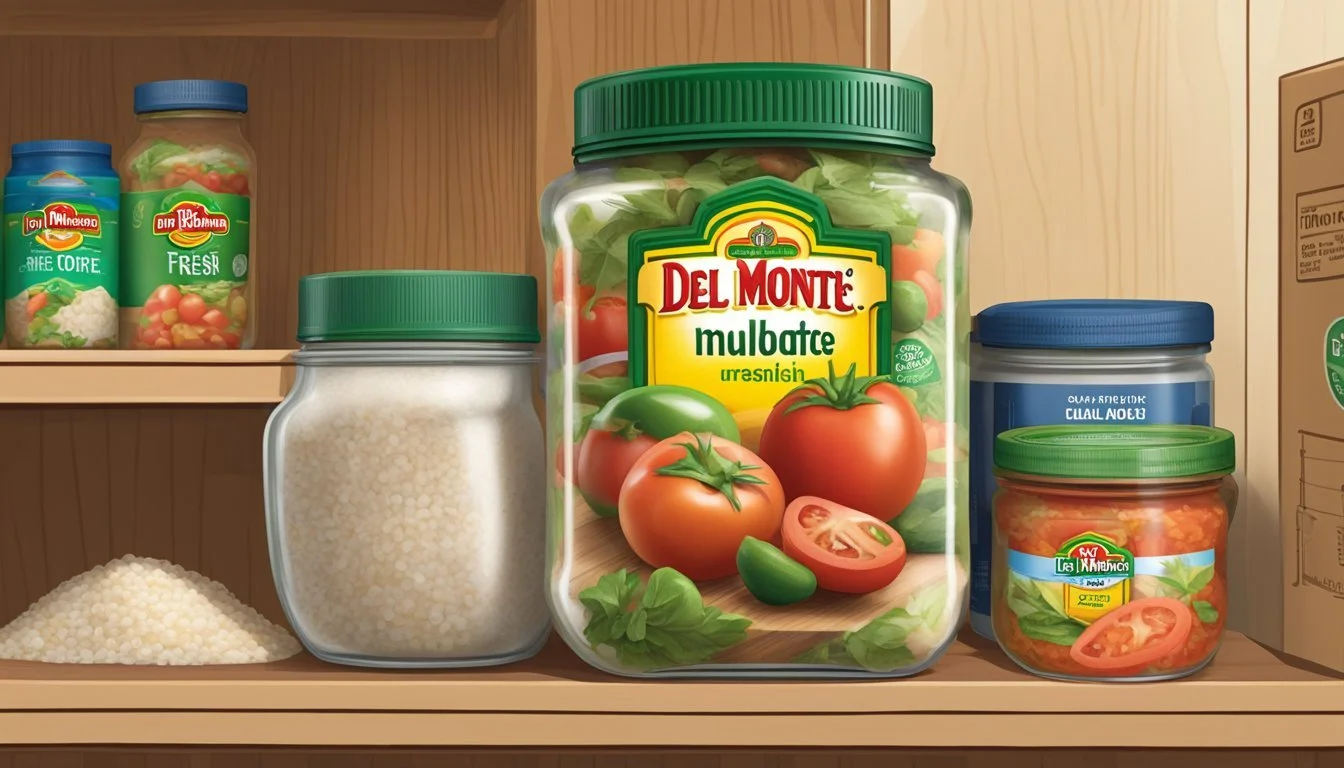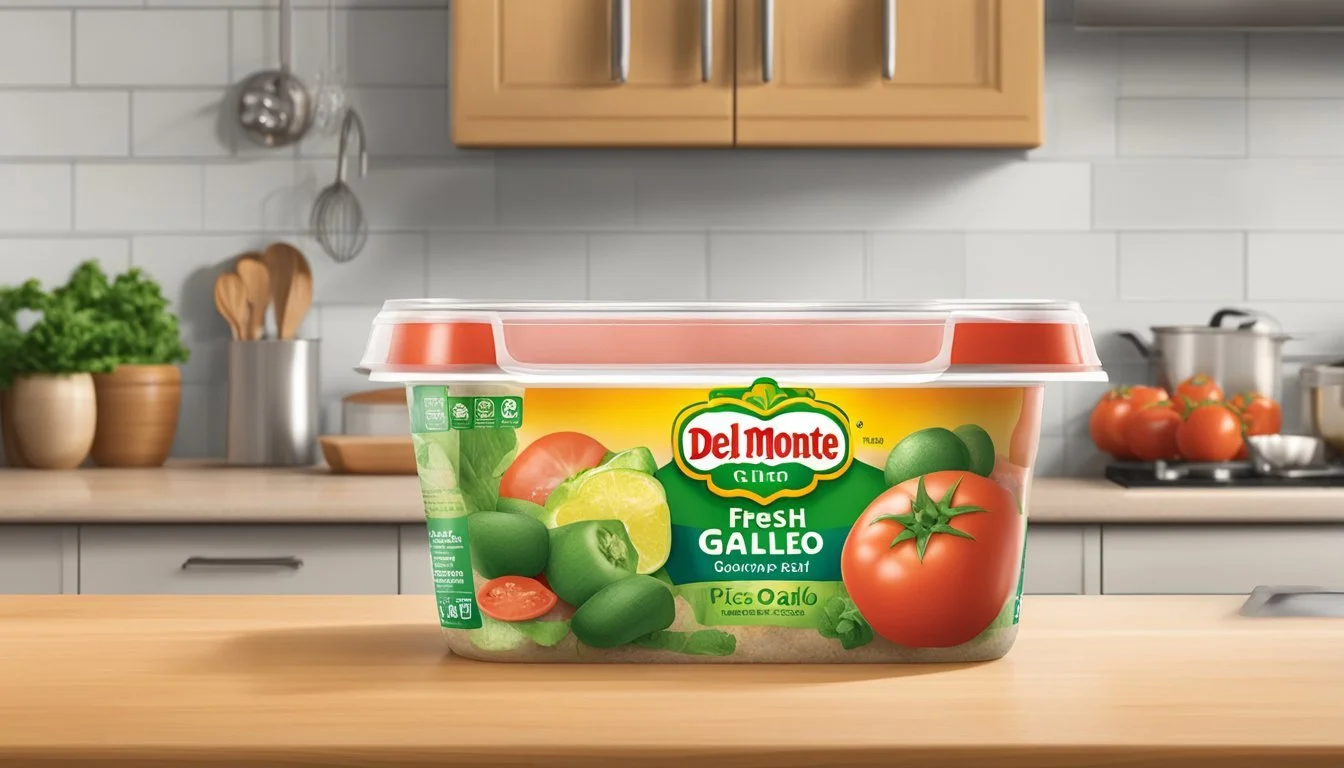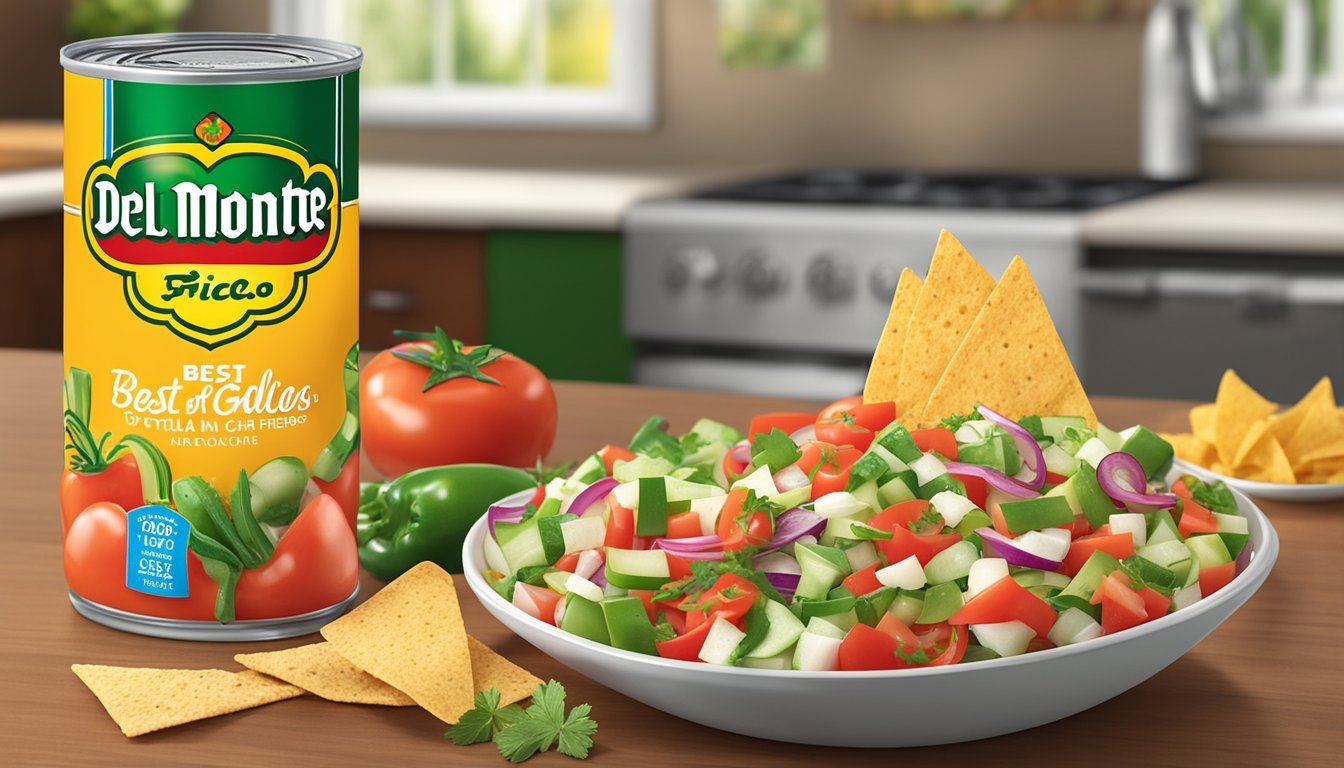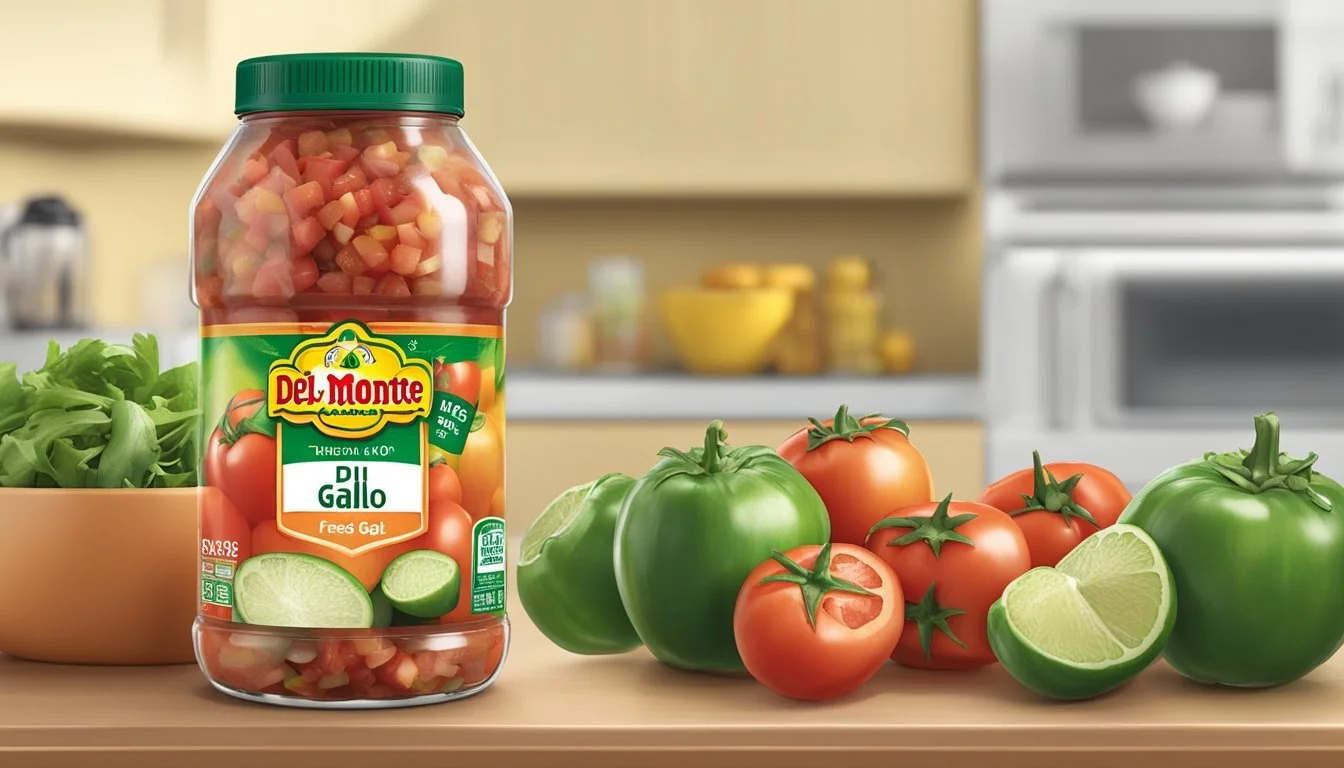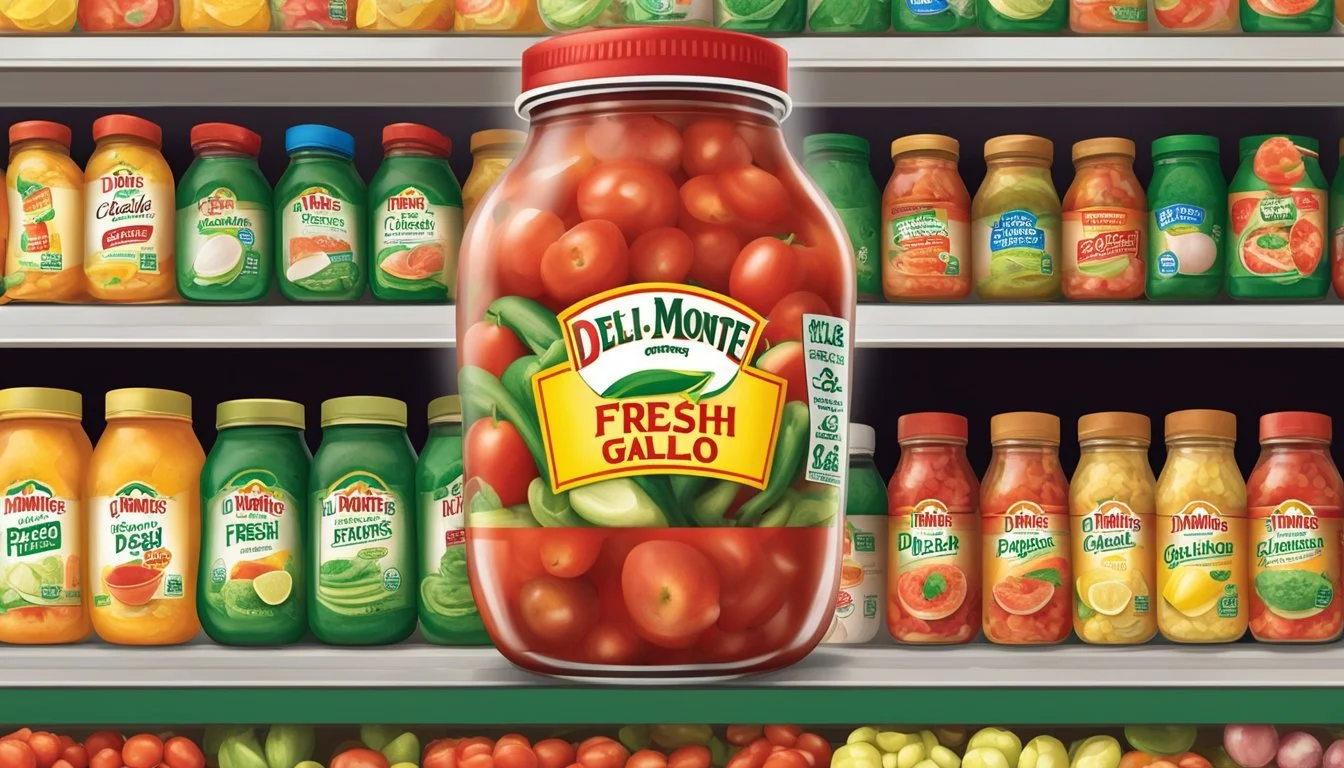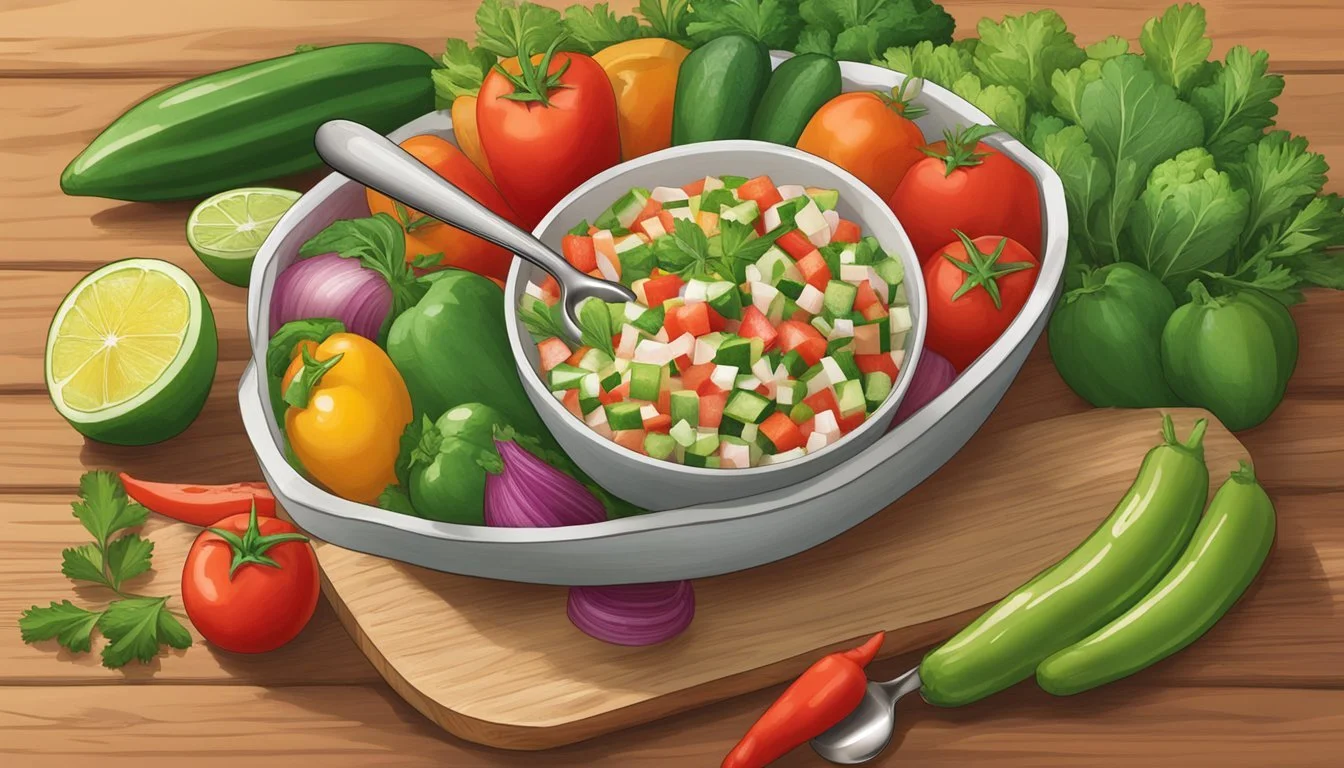How Long Does Del Monte Fresh Pico de Gallo Last?
Shelf Life and Storage Tips
Pico de gallo, a fresh salsa traditionally made with chopped tomato, onion, cilantro (how long does cilantro last?), fresh chiles, lime juice, and salt, is a staple of Mexican cuisine known for its bright, refreshing taste. When purchasing a pre-packaged fresh option such as Del Monte Fresh Pico de Gallo, the shelf life is a common concern for consumers looking for the convenience without sacrificing the quality and flavor of their dishes.
A key aspect of Del Monte Fresh Pico de Gallo's longevity is proper storage. Once purchased, it should be kept refrigerated and typically can last anywhere between 3 to 7 days. The cold environment of the refrigerator maintains the freshness of the ingredients and slows down the growth of bacteria. To maximize the shelf life of Del Monte Fresh Pico de Gallo, it should be stored in its original packaging or an airtight container if transferred.
Signs that the pico de gallo has passed its prime include a sour smell, discoloration, or a slimy texture. The presence of these signs indicates that the product should be discarded. For optimal taste and safety, it is often advised to consume fresh pico de gallo within 3 days after opening.
Understanding Pico de Gallo
Pico de Gallo, also known as 'salsa fresca', is a traditional Mexican condiment consisting primarily of diced tomatoes (What wine goes well with tomatoes?), onions, cilantro, lime juice, and jalapeño or jalapenos. One of the key elements that distinguish it from other salsas is its chunky texture and use of fresh ingredients. Typically, it's a mix of raw vegetables, making it a vibrant and refreshing topping or side dish.
Tomatoes: The base of Pico de Gallo, ripe yet firm, providing sweetness and body.
Cilantro: This herb adds a distinctive fresh and citrusy flavor.
Onion: Usually, white onions are used for their crispness and slight bite.
Lime Juice: Adds acidity, enhancing the other flavors and acting as a preservative.
Jalapeños: Offer heat; one can adjust the number of seeds removed to control the spiciness.
The beauty of Pico de Gallo lies in its versatility. It can range from mild to spicy depending on the amount of jalapeños included. By including or omitting the seeds, one can regulate the heat intensity as the seeds contain most of the capsaicin in peppers, which is responsible for the spiciness.
For those looking to explore variations, adding fruits like mango can impart a sweet and tropical twist to the traditional recipe. When preparing Pico de Gallo, it's crucial to chop the ingredients uniformly to ensure a harmonious blend with each bite. Freshness of ingredients plays a significant role in the flavor and shelf life of this dish, as it is best enjoyed when the vegetables are at their peak freshness.
Storage Recommendations
Proper storage is critical for maximizing the shelf life of Del Monte Fresh Pico de Gallo. To ensure safety and retain quality, it is important to control temperature, limit air exposure, and use appropriate containers.
Refrigeration
Del Monte Fresh Pico de Gallo should be maintained within the refrigerator at a temperature between 35°F (1.7°C) and 40°F (4.4°C). When stored under these conditions, it can last up to one week. Frequent checks on temperature consistency are advised to prevent bacterial growth.
Countertop and Room Temperature
Pico de Gallo should not be kept at room temperature for more than two hours. Serve it chilled and return it promptly to the refrigerator to avoid spoilage. Bacteria can multiply rapidly at temperatures between 40°F (4.4°C) and 140°F (60°C), a range known as the 'danger zone.'
Freezing Options
While freezing is an option, it is generally not recommended for Pico de Gallo due to textural changes when thawed. If one chooses to freeze, use a suitable airtight container with the air removed. Thaw in the refrigerator when ready to serve.
Airtight Containers Use
An airtight container with a secure lid is essential for storing Pico de Gallo in the refrigerator. It prevents excess air and water vapor from entering, maintaining the freshness and integrity of the ingredients. A layer of plastic wrap can also be placed directly over the Pico de Gallo before sealing, to minimize air exposure.
Shelf Life Determinants
The shelf life of Del Monte Fresh Pico de Gallo is influenced by a combination of factors including the freshness of ingredients, environmental conditions, and the quality of those ingredients. Understanding these determinants is crucial for maximizing the product's shelf life.
Freshness Factors
When considering freshness factors, two elements play crucial roles: water content and acidity. High water content in fresh ingredients, such as tomatoes and onions, can accelerate spoilage due to bacterial growth. Conversely, the acidity from ingredients like lime juice may act as a natural preservative, inhibiting bacteria and extending shelf life.
Texture: Ideally, the texture should be firm, indicating less breakdown and fresher produce.
Freshness: The rate at which ingredients lose freshness affects texture and taste, leading to spoilage.
Environmental Variables
Environmental variables such as temperature and air exposure significantly impact the longevity of Pico de Gallo.
Temperature: Should be kept between 35°F (1.7°C) and 40°F (4.4°C) to minimize bacterial growth.
Air: Pico de Gallo must be stored in an airtight container to reduce exposure to air which can lead to spoilage.
Ingredient Quality
Lastly, the quality of the ingredients used in Pico de Gallo, like fresh tomatoes, cilantro, and onions, directly relates to its shelf life.
Firmness: Selecting firm tomatoes and fresh, crisp onions can ensure a longer-lasting product.
Ingredient Quality: High-quality ingredients without bruises or damage are less likely to develop mold or spoil quickly.
Signs of Spoilage
When assessing the freshness of Del Monte Fresh Pico de Gallo, one must pay attention to several indicators that suggest spoilage. Spoilage can result from bacteria growth, which is accelerated when the product is not stored correctly or is kept beyond its shelf life.
Visual Signs:
Discoloration: Fresh pico de gallo is vibrant in color. If one notices any dullness or off-colors, it may indicate spoilage.
Mold: The presence of fuzzy or slimy mold spots is a clear sign that the pico de gallo should not be consumed.
Texture Changes:
Slimy Texture: A slippery or gooey consistency is often the result of bacterial growth and is a sign the product should be discarded.
Soft Spots or Bruising: While softness can be natural in ripe tomatoes, excessive soft spots may signal decay.
Aroma and Taste:
Aroma: An off or unpleasant aroma is a strong indicator that the pico de gallo is no longer safe to eat.
Rancidity: If the product has a sour or rancid taste, it is a clear sign that it has gone bad.
Water Content:
Excessive water pooling at the bottom of the container can dilute flavor and may promote bacterial growth, further increasing the risk of spoilage.
In conclusion, consumers should trust their senses when evaluating the freshness of Del Monte Pico de Gallo. Any doubt should lead to disposal of the product to prevent the risk of foodborne illness.
Safe Consumption Practices
When enjoying Del Monte Fresh Pico de Gallo, consumers should prioritize food safety to prevent foodborne illnesses typically associated with improper handling and storage of fresh produce. It is imperative to adhere to cleanliness and hygiene standards from preparation to consumption.
Storage: One should store the pico de gallo in the refrigerator, ideally between 35°F (1.7°C) and 40°F (4.4°C). This temperature range inhibits harmful bacterial growth. The product should remain in its original packaging until used, or if transferred to another container, the container must be airtight.
Hygiene: Washing hands thoroughly before handling the pico de gallo is crucial. All utensils and surfaces that come into contact with the food should be clean and sanitized to prevent cross-contamination.
Shelf Life: It's advised to consume Del Monte Fresh Pico de Gallo within three to four days after opening. The presence of any off-odors, discoloration, or sliminess indicates that the product should not be consumed and be disposed of immediately.
Inspect Before Use: Before consumption, one should visually inspect the pico de gallo for signs of spoilage. If the product has exceeded its expiration date or shows any signs of mold or degradation, it should not be used.
Following these safety guidelines will ensure that Del Monte Fresh Pico de Gallo is enjoyed at its peak freshness and flavor while minimizing the risk of consuming harmful bacteria.
Maximizing Freshness and Flavor
When preparing Del Monte Fresh Pico de Gallo, one should focus on maintaining the quality and enhancing the natural flavors of the ingredients. Implementation of proper mixing techniques, balancing acidity, and thoughtful seasoning can significantly influence the freshness and enjoyment of the final product.
Proper Mixing Techniques
The method of combining ingredients for Pico de Gallo affects its texture and flavor distribution. Gently fold in the finely chopped ingredients to ensure a consistent mix without crushing the delicate pieces of tomato or cilantro. Doing so helps maintain a desirable, chunky texture, integral to the enjoyment of Del Monte Fresh Pico de Gallo.
Adding Acidity
Incorporating the right amount of lime juice is crucial for maximizing flavor. Lime juice not only adds a zesty acidity that enhances the overall taste but also contributes to the product's freshness. Use fresh lime juice to accentuate the natural flavors of the tomatoes and cilantro, aiming for a balance that complements rather than overpowers.
Seasoning and Salt Usage
Salt is pivotal in enhancing the Pico de Gallo's flavor profile. It should be used judiciously to amplify the freshness of the produce and the zestiness of the lime. However, over-salting can overwhelm the inherent taste of the ingredients. Begin with a small amount, mix, taste, and adjust as necessary.
Herbs and Spices Selection
The choice and quality of herbs and spices, namely cilantro and jalapeños, play a significant role in the overall flavor of Pico de Gallo. One should select fresh, vibrant herbs and adjust the quantity of jalapeños to suit the desired spice level, ensuring these additions heighten the flavor rather than dominate it. Freshness in these ingredients is paramount for an enticing and enjoyable Pico de Gallo.
Usage Ideas and Serving Suggestions
Del Monte Fresh Pico de Gallo is a versatile condiment that can enhance the flavor of various dishes. It fits seamlessly into several culinary applications, from traditional Mexican meals to innovative modern recipes.
Traditional Mexican Cuisine
In traditional Mexican cuisine, Pico de Gallo is a staple condiment. One can often find it served alongside:
Tacos: Adding a spoonful on top of beef, chicken, or fish tacos for a fresh taste.
Mexican Salsas: Incorporating it into salsas to give a chunkier texture.
Accompaniments and Sides
Pico de Gallo is more than just a condiment; it's an integral side that complements a variety of dishes:
Chips: Serve with tortilla chips as a fresh, flavorful dip.
Nachos: Spoon over nachos with melted cheese for added zest.
Creative Variations
To appeal to a wide range of tastes, one might get creative by adding ingredients like:
Avocado: Mix Pico de Gallo with chunks of avocado for a quick guacamole twist.
Mango: Create a sweet and savory salsa fresca by adding ripe mango.
Del Monte Fresh Pico de Gallo offers a burst of freshness to any dish it accompanies, proving its versatility beyond traditional Mexican recipes.
Homemade Pico de Gallo Preparation
Preparing homemade Pico de Gallo involves simple ingredients and techniques, ensuring a fresh and flavorful addition to a variety of dishes. Accurate cutting and handling methods, along with an understanding of preparation time, are critical for creating this classic condiment.
Basic Recipe and Ingredients
Ingredients:
Tomatoes: Fresh, ripe tomatoes are essential, with plum tomatoes often preferred for their firmer flesh.
Onion: Typically, white onions are utilized for their crisp texture and slightly sweet flavor.
Cilantro: Fresh cilantro is key for an authentic, herby taste.
Jalapeño Peppers: These add a spicy kick. The seeds can be removed to reduce heat.
Lime Juice: Freshly squeezed lime juice is used to brighten the flavors.
Salt and Pepper: To taste, enhancing the overall profile of the Pico de Gallo.
For a standard batch, mix the following:
Diced tomatoes: 2 cups
Diced onions: 1/2 cup
Chopped cilantro: 1/3 cup
Minced jalapeño: 1 tablespoon (adjust based on heat preference)
Lime juice: 2 tablespoons
Salt & pepper: To taste
Handling and Cutting Techniques
The quality of homemade Pico de Gallo relies heavily on how the ingredients are handled and prepared. For tomatoes and onions, a sharp knife is necessary to achieve a clean dice without crushing the flesh. Onions should be cut finely to distribute their flavor throughout. Cilantro leaves should be picked from the stems and roughly chopped. When dealing with jalapeños, one should wear gloves to prevent irritation from capsaicin and finely mince the pepper for even distribution of spice.
Preparation Time and Speed
A proficient cook can prepare Pico de Gallo in approximately 10 minutes. The key to a speedy preparation is organized mise en place—having all ingredients cleaned, ready, and within reach before starting. This quick preparation time ensures that the ingredients retain their freshness and vibrant flavors, which is the hallmark of a great homemade Pico de Gallo.
Health and Nutrition Facts
Del Monte Fresh Produce Pico de Gallo is a fresh, raw salad that combines vegetables and sometimes fruits, providing a health-conscious topping or side dish option. The nutritional value of this product is characterized by its low-calorie content and a good source of various vitamins and minerals.
Calories and Macronutrients:
Calories: Pico de Gallo generally contains low calories, making it suitable for calorie-conscious diets. Different sources suggest varying calorie contents, but on average, a serving size of 100 grams may contain around 17-25 calories.
Protein: It offers a modest amount of protein (0.7g per 100g), which is essential for repairing tissues and supporting immune function.
Carbohydrates: Carbs are present primarily in the form of natural sugars and dietary fiber (around 3.7g per 100g), which can aid in digestion.
Fats: Pico de Gallo is low in fat (0.1g per 100g), contributing to its fresh taste without adding significant fat content to one's diet.
Vitamins and Minerals:
Vitamin C: As a fresh salad, it is a good source of vitamin C, an antioxidant that supports the immune system and skin health.
Potassium: It contains potassium, which is crucial for maintaining a healthy blood pressure.
Phosphorus: Phosphorus is also present, playing an important role in bone health.
Overall, Del Monte Fresh Produce Pico de Gallo brings together a medley of vegetables and fruits in a minimally processed form, keeping the integrity of the ingredients and offering a nutrient-rich option for those aiming to incorporate more raw vegetables into their diet.
Variations and Alternatives
When considering alternatives to Del Monte's fresh pico de gallo, one may encounter a variety of options, each with its own shelf life and flavor profile. Del Monte's pico de gallo typically includes tomatoes, jalapeños, cilantro, and lime juice, and it is known for its freshness. Here are some notable variations:
Canned Varieties: Canned options offer a longer shelf life when unopened but may vary in taste and texture. Upon opening, they should be consumed within 5-7 days and stored in the refrigerator.
Spicy and Mild Variants: Adjusting the level of jalapeño peppers or substituting them with milder or spicier peppers can tailor the heat to personal preference. This does not significantly alter the shelf life.
Avocado Pico de Gallo: Incorporating avocado can add creaminess to the dish, but it may shorten the refrigerator life due to the avocado oxidizing. It is best when consumed within 1-2 days after making.
Addition of Onions and Garlic: White onion and garlic are often added to improve savory notes. These ingredients do not have a substantial impact on the duration of freshness when stored properly.
Pepper Variations: Switching jalapeños for other peppers like serrano or bell peppers not only changes the flavor and spiciness but can also affect the water content, potentially impacting longevity.
Salsa and Sauces: As alternatives, pre-made salsas and sauces offer convenience. Their expiration dates and preservatives dictate their shelf-life, which is typically longer than fresh pico de gallo.
The table below summarizes the shelf life of each variant when stored in the refrigerator:
Variant Shelf Life Canned (Unopened) Best by date on can Canned (Opened) 5-7 days Spicy/Mild Fresh Pico de Gallo 3-7 days Avocado Pico de Gallo 1-2 days With White Onion/Garlic 3-7 days Different Peppers 3-7 days (may vary) Pre-made Salsas/Sauces See package for expiration
Note: These are approximate durations and can be affected by storage conditions and ingredient freshness.
Understanding Expiration and Safety
When considering the expiration and safety of Del Monte Fresh Pico de Gallo, it's essential to pay attention to the expiration date. This date serves as the manufacturer's estimate of how long the product can be expected to retain optimal quality. However, this does not necessarily mean the product will instantly become harmful after this date, but its freshness and flavor may degrade.
Safe Storage Practices:
Keep the pico de gallo refrigerated.
Ensure the container is airtight to limit exposure to air.
Indicators of Spoilage:
Scent: An off-putting odor signifies spoilage, as fresh pico de gallo should smell mild and refreshing.
Appearance: Discoloration or mold growth indicates bacterial activity.
PH Levels and Safety: Pico de Gallo's acidity, often from lime juice or tomatoes, can act as a natural preservative. Lower pH levels inhibit the growth of harmful bacteria that lead to foodborne illness. However, consumers should still be cautious, as natural preservatives have limitations.
Consumers should be vigilant against the risk of foodborne illness by discarding pico de gallo if there are signs of spoilage. While fresh ingredients can help delay the onset of harmful bacteria, they do not eliminate the risk entirely.
To Summarize:
Always check expiration dates and examine the product closely before consumption.
Look for natural preservatives like citrus juice, but don't rely on them solely for safety.
If there are any doubts about the quality of the pico de gallo, err on the side of caution and dispose of it to prevent the risk of foodborne illness.
Tips for Selection and Purchase
When purchasing Del Monte fresh pico de gallo, consumers should pay attention to several indicators of quality to ensure they are selecting the freshest product. Here are some guidelines:
Firmness: Check for firmness in the tomatoes. They should yield slightly under gentle pressure, but not feel overly soft or mushy.
Freshness: Fresh pico de gallo will have vibrant colors and a crisp appearance. Avoid any containers that have excess liquid pooling at the bottom, as this suggests the product has been sitting for some time.
Bruising: Examine the container for signs of bruising on the tomatoes and other ingredients. Bruises can lead to faster spoilage and diminish the quality of the pico de gallo.
Discoloration: Avoid any pico de gallo with discoloration, which could indicate age or improper storage.
Quality Indicator What to Look For What to Avoid Firmness Slight yield to pressure Softness, mushiness Freshness Vibrant colors, crisp look Excess liquid, wilted herbs Bruising No visible bruising Dark spots, dents Discoloration Uniform, bright appearance Dull colors, brown edges
It's advised to consume Del Monte fresh pico de gallo soon after purchase to enjoy its best quality. Checking these quality indicators at the time of purchase can lead to better satisfaction with the product's taste and texture.
Pico de Gallo in Commercial Packaging
When purchasing Del Monte Fresh Pico de Gallo, consumers find it in various types of commercial packaging. Typically, it is sold in plastic containers with snap-on lids or sealed pouches, which are designed to maintain its freshness and flavor. Commercially packaged pico de gallo often includes an expiration date, advising consumers of the last recommended consumption date for optimal quality.
For canned varieties, Del Monte ensures that its pico de gallo is sealed airtight within cans to prolong shelf life. However, unlike other canned goods, pico de gallo does not last indefinitely. Once opened, the freshness of the pico de gallo begins to decline.
The shelf life of commercial pico de gallo can be influenced by various factors:
Preservatives: Some packaging may include preservatives to extend the salsa's edible period.
Storage temperature: Refrigeration is paramount; it should be kept between 35°F (1.7°C) and 40°F (4.4°C) to inhibit bacterial growth.
Seal integrity: A strong, intact seal helps prevent oxidation and contamination.
Here are some practical tips for handling Del Monte's packaged pico de gallo:
Upon opening, consume within 3-7 days, before the quality diminishes.
Look for cloudiness or an off odor as signs of spoilage.
Follow any specific storage instructions provided on the packaging to ensure safety and freshness.
Culinary Techniques and Enhancements
When preparing Del Monte Fresh Pico de Gallo, certain culinary techniques can enhance the flavors and potentially extend its shelf life. Though typically a simple dish, minor adjustments and additions can add depth to the taste profile of this Mexican condiment.
Firstly, selecting quality ingredients is paramount. The freshness of tomatoes, onions, and cilantro contributes to both the flavor and how well the Pico de Gallo will keep. A judicious use of olive oil can add a subtle richness, though traditionally, it is not a common ingredient in Pico de Gallo.
Recipe Adjustments:
Garlic: While not traditional, some recipes may include a small amount of finely minced garlic for a bolder flavor. It should be used sparingly to ensure it does not overpower the other ingredients.
Acid Balance: Balance the lime juice to taste, as the acidity can act as a light preservative and add zing to the dish.
Storage Tips:
Temperature: Store the Pico de Gallo at a consistent 35°F-40°F.
Container: Use an airtight container to limit exposure to air, which can degrade quality.
By integrating these minor enhancements and techniques, the resulting Pico de Gallo can be a tasteful balance of traditional and personalized flavors, with an optimized shelf life. Remember, while olive oil and garlic may add distinct tastes, they should complement rather than dominate the fresh quality that defines Pico de Gallo.


